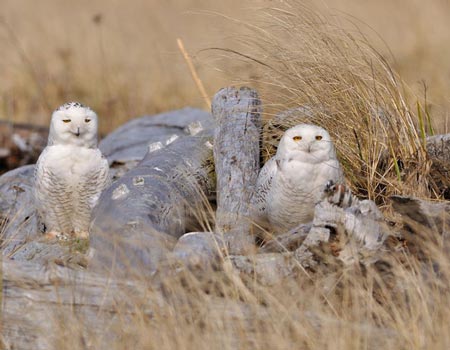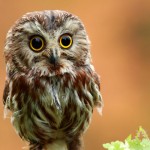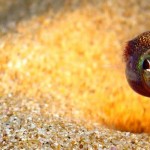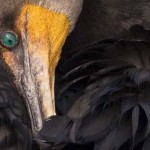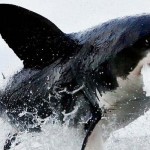A year ago, January 2011: Norman Smith steers his truck over a washboard bridge that crosses from the Massachusetts mainland onto Duxbury Beach, a slender barrier peninsula thirty miles southeast of Boston. Jagged ice floes push up and over the road that runs the length of the beach,whose sands are buried under the seven feet of snow that have fallen this month. “Who in his or her right mind would be out here on a day like this?” asks Smith, a raptor biologist. But the reason for his mission is evident—riding in a cage on the truck’s flatbed is a snowy owl he is about to return to the wild. It was captured earlier in the day at Boston’s Logan International Airport.The owl is a male that was hatched somewhere in the far north the previous summer. Smith trapped it with a bow net—a spring-loaded hoop net that holds a live pigeon, starling, or mouse whose movements attract the owl. “The trap is sprung with a hand-held trip wire,” explains Smith, “and causes no injury to the owl or the bait.” After an owl is eased out from under the net, Smith weighs and measures it, and checks its overall condition. He then places a metal band issued by the U.S.Fish and Wildlife Service on one of its legs.
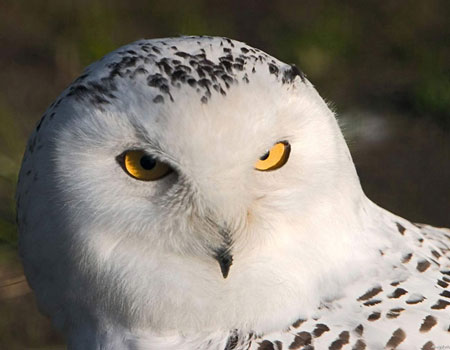 Snowy owls, Bubo scandiacus, breed during the Arctic summer on the open tundra above 60 degrees north latitude.When harsh autumn and winter weather arrives, and lemmings and other small mammals the owls prey on go underground, the birds fly south, settling until spring “anywhere that looks like home,” says Smith.The land around Logan Airport is a favored spot.“It’s low and relatively flat,” says Smith,“with short scruffy grasses and marshy areas.The owls have an abundance of food—voles, Norway rats, and smaller birds. Logan attracts more wintering snowy owls than anywhere in the U.S.” Since 1981, when the airport surveillance began,documented prey has also included brant goose, Canada goose, great blue heron, assorted waterfowl, and even other raptors—American kestrel,barn owl,northern harrier, peregrine falcon, and short-eared owl.
Snowy owls, Bubo scandiacus, breed during the Arctic summer on the open tundra above 60 degrees north latitude.When harsh autumn and winter weather arrives, and lemmings and other small mammals the owls prey on go underground, the birds fly south, settling until spring “anywhere that looks like home,” says Smith.The land around Logan Airport is a favored spot.“It’s low and relatively flat,” says Smith,“with short scruffy grasses and marshy areas.The owls have an abundance of food—voles, Norway rats, and smaller birds. Logan attracts more wintering snowy owls than anywhere in the U.S.” Since 1981, when the airport surveillance began,documented prey has also included brant goose, Canada goose, great blue heron, assorted waterfowl, and even other raptors—American kestrel,barn owl,northern harrier, peregrine falcon, and short-eared owl.
Snowy owls usually start landing at the airport in early November, and don’t begin to leave until early April. “When Logan calls,I go,”Smith says.Owls and aircraft can be a threat to each other. Smith has captured and released more than 400 snowy owls at Logan.“Snowy owls have a benefit for the airport,though,”he says.“They scare away other birds that congregate and pose a threat to planes.”
Smith is Director of the Blue Hills Trailside Museum in Milton, Massachusetts, which is managed for the state by the Massachusetts Audubon Society. Smith is also director of the Snowy Owl Telemetry Research Project, a joint venture of the Raptor Research Center at Boise State University and the U.S. Geological Survey’s Forest and Rangeland Ecosystem Center in Idaho.Some of his charges leave with a souvenir of their visit—a small backpack with a Platform Transmitter Terminal (PTT) that can be tracked by satellite.Today’s owl is wearing one: he will be known as owl 099907,the number of the transmitter issued by Argos, a worldwide tracking and environmental monitoring service administered by the U.S.National Oceanic and Atmospheric Administration and the French Space Agency.
“A lot of research has been done to determine the best size, weight, positioning, and attachment of PTTs so they don’t affect the wildlife being followed,” says Smith. He attaches PTTs only to the healthiest snowy owls released along the beach.Two Teflon ribbons go over a bird’s body in front of the wing, cross over its breastbone, and return behind its wing to attach to the opposite corners of the device.The birds quickly preen their feathers over a PTT until the only part visible is the antenna.
Once a PTT is turned on, it sends data such as air temperature and altitude in short bursts.The “downloads” are received by weather satellites that also fix the location of each transmission.The data is stored and retransmitted to ground stations, passed on to processing stations, and distributed to researchers. Because transmitter batteries last for three years, scientists can track an owl’s path through several round-trips to the Arctic.The transmitter harness is designed to fall off after the life of the battery has been reached.
Halfway down the beach, Smith brings his truck to a skidding halt against an ice bank on the side of the road. He slips out and opens the cage door.With an outstretched arm,gently holding its talons,Smith faces owl 099907 into the wind.Icy white sky blends with insulating white plumage.The owl flaps once, turns due north, and disappears.
 Snowy owls breed in May in Alaska, Canada, Greenland, and northern Eurasia. Sites with good visibility, easy access to hunting areas, and lack of snow are prime real estate.The eggs hatch some five weeks later when the Arctic Sun is at its zenith and prey are most active. It takes a lot of lemmings to raise a snowy owlet. Biologists estimate that a pair of snowy owls and a brood of nine owlets consume 1,900 to 2,600 lemmings, or about 325 pounds of lemming meat, during the breeding season from May to September. Other raptors use thermals, or rising air currents, to stay aloft for the hunt, but snowy owls hover. They also watch for prey from perches. In summer they hunt during the long Arctic days; in winter, they may be more nocturnal, like most owls.
Snowy owls breed in May in Alaska, Canada, Greenland, and northern Eurasia. Sites with good visibility, easy access to hunting areas, and lack of snow are prime real estate.The eggs hatch some five weeks later when the Arctic Sun is at its zenith and prey are most active. It takes a lot of lemmings to raise a snowy owlet. Biologists estimate that a pair of snowy owls and a brood of nine owlets consume 1,900 to 2,600 lemmings, or about 325 pounds of lemming meat, during the breeding season from May to September. Other raptors use thermals, or rising air currents, to stay aloft for the hunt, but snowy owls hover. They also watch for prey from perches. In summer they hunt during the long Arctic days; in winter, they may be more nocturnal, like most owls.
Averaging a two-foot height (females are the larger sex) and a five-foot wingspan, snowy owls are the heaviest and among the largest owls in North America. Adult males usually become almost pure white as they mature and age; females and immature males have dark barring, and juvenile owls are heavily spotted.The white feathers, observes biologist Gary Bortolotti of Canada’s University of Saskatchewan, reflect sunlight across miles of treeless landscape. Over the course of a day, the owls rotate to face the Sun,which,Bortolotti and his colleagues think,broadcasts a bright territorial signal to rivals and potential mates.
As the days grow shorter and the cold begins to return, snowy owls take flight, sometimes arriving as far south as Georgia,Texas, and even the Caribbean.The fall of 2011 and winter of 2012 have brought a multitude of sightings in New England and other parts of the United States as snowy owls turned up in peak numbers. During this recent “irruption,” one owl even landed at Honolulu International Airport, Hawaii, on Thanksgiving Day (some speculate it may have ridden ships on the way). Wildlife biologists at the U.S. Department of Agriculture Animal and Plant Health Inspection Service were called in and tried for three hours to chase it away from the runways,but without success.The owl was shot and killed as a hazard to planes landing and taking off. It proved to be a male; the prepared skin now ranks as a unique specimen at the Bishop Museum.
Irruptions happen at irregular intervals across different parts of the continent.For a long time scientists believed that this occurred when lemming populations crashed, forcing snowy owls to head south in search of alternate prey. But the thinking has changed.“We actually see the most snowy owls in New England after an Arctic lemming population boom, not bust,” Smith says. More lemmings mean more owls, and so more owls to fly south. Jean-François Therrien, a biologist at Laval University in Quebec, Canada, has been monitoring owls on Baffin Island and on Bylot, a small island to its north. In years when lemming populations are high, there are good numbers of owls breeding. During those winters,lots of owls turn up at Logan.“If in fact snowy owls in the Arctic were starving and moving south,” says Smith,“then why are they mostly ‘hatch-year’ owls that show up in good condition? I am not aware of any owls that are starving this winter. In the past, ones that were emaciated had some other issue—broken bone, electrocution, fungal infection, et cetera—that made it so they couldn’t hunt and ultimately died of starvation.”
Smith reports the influx at Logan Airport this winter is similar to that of the last irruption, which happened during the winter of 2008-2009.Then he banded thirty-nine snowy owls. So far this season, as of the end of January, he has caught and banded twenty-one, and has already sighted others that await capture.The best winter was 1986-1987, when more than fifty came through, and Smith banded forty-three.“In January 1987,” he recalls,“we had twenty-three snowy owls on the airfield that we could see at one time!”
The Snowy Owl Telemetry Research Project is also changing long-standing beliefs.Among the findings is that most adult female snowy owls breeding in the Canadian Arctic overwinter in the eastern Arctic region.There they spend several weeks on the sea ice between December and April. Satellite images show that the owls gather on the edges of open-water patches, the better to hunt eider ducks and other seabirds.“This dependence on sea ice and seabirds by snowy owls—tundra predators that were long considered small-mammal specialists—was completely unexpected,” says Therrien. “Marine species such as waterfowl may be heavily ‘subsidizing’ snowy owl populations in winter.” With sea ice cover expected to shrink due to global warming,says Therrien,“it may affect snowy owls—and ultimately the entire tundra ecosystem.”
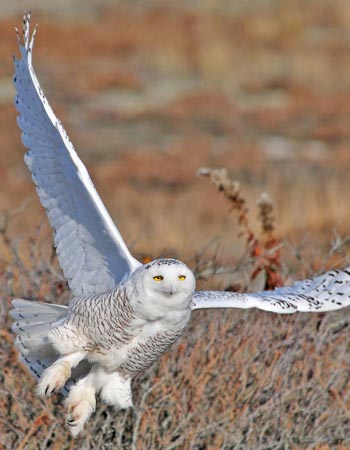 Other results are accumulating.Through transmitter data, Smith has discovered that some snowy owls that winter in Massachusetts head northwest through New Hampshire and Vermont to spend their summers in northern Quebec and on Baffin Island, sometimes above the Arctic Circle. Other transmitter-carrying owls summer near northern Quebec, then winter along the St. Lawrence Seaway, or move along the eastern edge and southern rim of Hudson Bay.Tracking studies in collaboration with the Owl Research Institute in Charlo, Montana—which has been following snowy owls for twenty years—have also shown the owls flying at high latitudes east and west from Barrow, Alaska—west to Russia and east to Canada.Conservation of the species will require large-scale, international efforts to protect habitat.
Other results are accumulating.Through transmitter data, Smith has discovered that some snowy owls that winter in Massachusetts head northwest through New Hampshire and Vermont to spend their summers in northern Quebec and on Baffin Island, sometimes above the Arctic Circle. Other transmitter-carrying owls summer near northern Quebec, then winter along the St. Lawrence Seaway, or move along the eastern edge and southern rim of Hudson Bay.Tracking studies in collaboration with the Owl Research Institute in Charlo, Montana—which has been following snowy owls for twenty years—have also shown the owls flying at high latitudes east and west from Barrow, Alaska—west to Russia and east to Canada.Conservation of the species will require large-scale, international efforts to protect habitat.
Transmitter data in 2011 revealed that owl 099907 first headed back to Logan Airport, where he lingered through February. In spring, he went on to the St. Lawrence Seaway, an area where other owls have also been recorded on their way north. Then he flew north to the Opinaca Reservoir, arriving east of James Bay, Quebec, by May 13 .That location was still south of the breeding grounds.No further movements were observed between May 13 and September 30,the date of the last transmission.The owl may have perished at Opinaca Reservoir.
Or he may have simply rid himself of the PTT backpack in mid-May and proceeded north to breed. He still has his leg band and might someday be recaptured and identified. “We have had a number of owls come back to the airport in subsequent years,” Smith says, “including one that returned sixteen years after banding, which is currently the oldest wild snowy owl on record.”
In the meantime, other messengers from the Arctic are arriving on winter’s winds.

